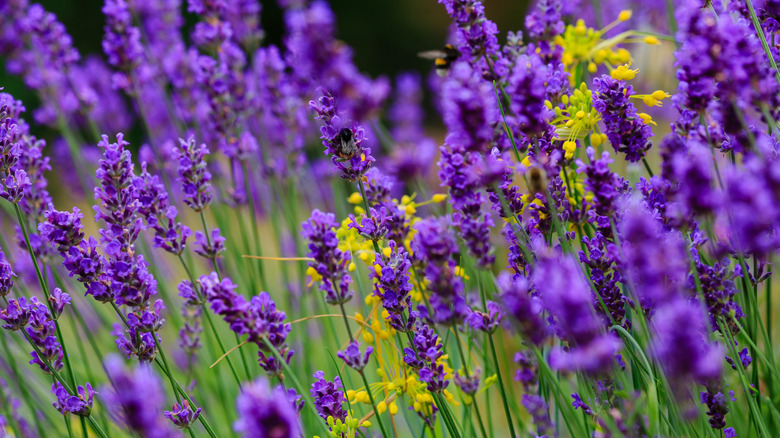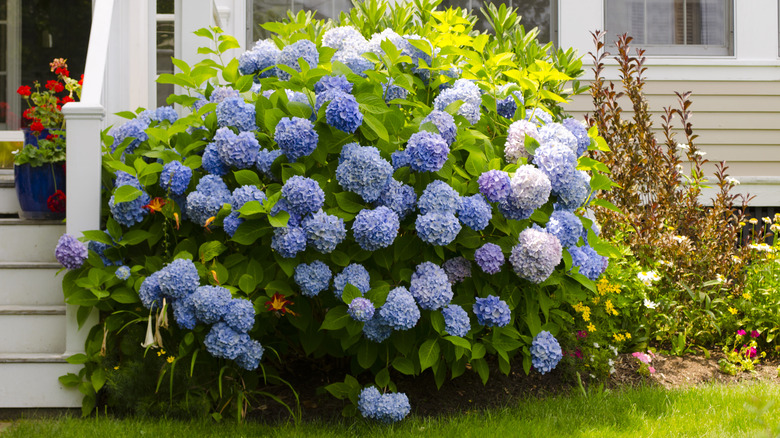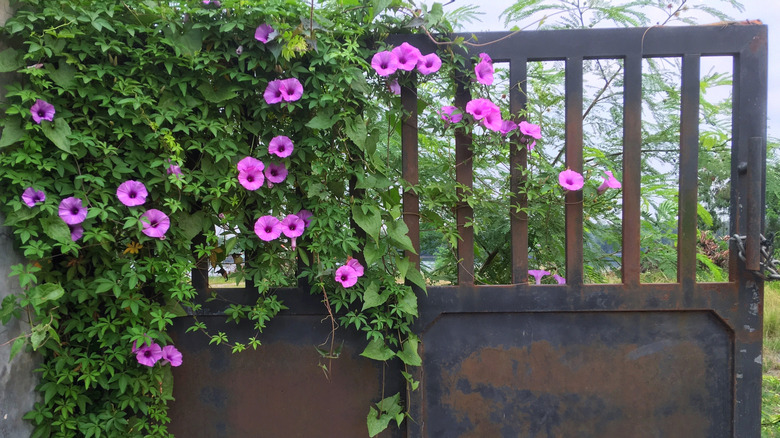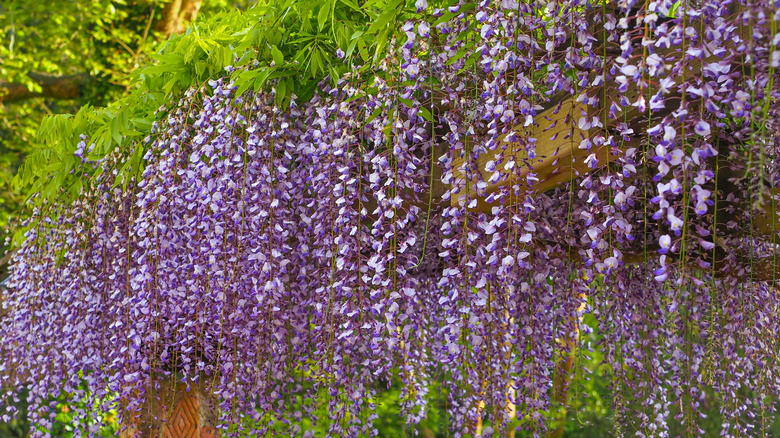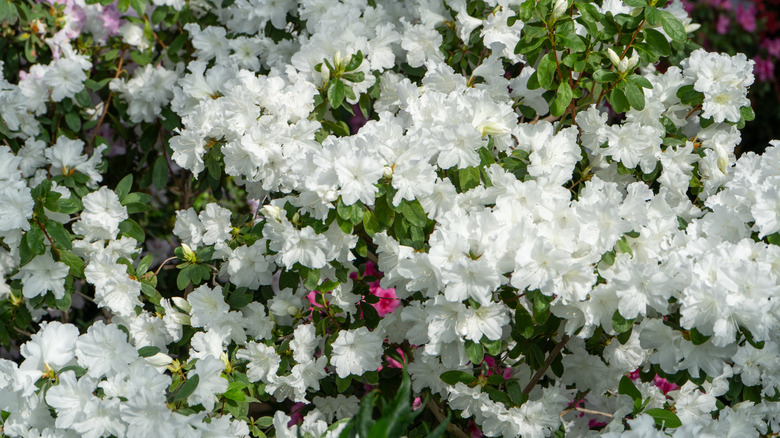10 Popular Plants That Expert Gardeners Warn Beginners Not To Grow
There's nothing like the feeling you get from watching something you have planted thrive. Unfortunately, not all plants are easy to care for. Some demand a lot of attention, need particular soil conditions, or require just the right amount of sunlight and water. Other plants seem to be prone to every disease and pest in the garden. The hard truth about being a beginner gardener is that when you first get started, it can be really overwhelming trying to figure everything out. You may have a plant or two die. While that is part of the learning process, it doesn't make it any easier. Choosing high-maintenance or difficult-to-grow plants when you're starting out can quickly discourage even the most enthusiastic new gardener. That's why some experienced gardeners caution newcomers to steer clear of high-maintenance favorites like gardenias, roses, dahlias, azaleas, hydrangeas, and even lavender.
Starting off with some of the easiest plants to grow for beginner gardeners, like marigolds (Tagetes patula), petunias (Petunia spp.), and sunflowers (Helianthus annuus), allows beginners to get their feet wet slowly. These hardier plants are more forgiving of the mistakes you want to avoid as a beginner, like overcrowding or not fertilizing properly. As experience levels grow and knowledge increases, you will be able to try your hand at some of these more difficult plants. There is no rule that says you can't try the really finicky plants right off the bat, but for best results (and less frustration), build your experience slowly and choose plants that are not so temperamental.
Gardenias
As pretty as gardenias (Gardenia jasminoides) are, they can be a real challenge for beginner gardeners. According to a Clemson Cooperative Extension article written by Clemson University horticultural specialists Marjan Kluepfel and Robert F. Polomski, PhD, "Gardenias are not the easiest shrubs to grow." They go on to state: "Gardenias require considerable maintenance." These high needs are a major reason gardenias are not a good choice for beginners. The care they require is better suited to experienced gardeners with knowledge on how to maintain humidity and manage a watering schedule.
Lavender
Lavender (Lavandula angustifolia) isn't necessarily difficult to grow, but it does have specific needs that beginners may find a bit overwhelming. Ruth Hayes, an Royal Horticultural Society-trained gardener, shared with Homes & Gardens: "If they are planted in the right place and given the right care, lavender bushes can last for years, but they are quick to fail if they are not happy." This quick-to-fail tendency can make them very difficult for beginners just learning about watering, sunlight, fertilizing and pruning needs.
Roses
Roses (Rosa spp.) are very popular, but they are not necessarily easy to grow. They can be a real challenge for the beginner gardener, depending on which varieties they choose. Alicia R. Lanborn, Horticulture Extension Agent at Baker County Extension Service, shared in Highlights in Horticulture: "High-maintenance types include hybrid tea, grandiflora, floribunda, and polyantha roses, all of which demand constant grooming, fertilizing, watering and spraying to perform well." There are lower-maintenance cultivars you could try, such as 'Bourbon' and 'China.' But if you're looking for a hands-off flower to start with, roses aren't a good choice.
Hydrangeas
Hydrangea (Hydrangea spp.) bushes are not that difficult to grow, but they do require specific growing conditions that beginner gardeners may find overwhelming. As horticulturalist Laura Root says via The Spruce, "They prefer consistent moisture and soil that stays damp but not soggy. Over-watering can cause root rot, while letting the soil dry out stresses the plant." She also notes that they're best planted in the spring, which is a busy time for any gardener, let alone beginners. Add in particular soil pH needs and pruning, and it's easy to see why a newbie may be hesitant.
Morning glory
Morning glory (Ipomoea purpurea) may look lovely, but it has a bad reputation because of how it takes over wherever it's planted. In an article on the Georgia Wildlife Resources Division website, Terry W. Johnson talks about his personal experiences with morning glory, and how invasive it can get when not kept in check. Morning glory not only likes to take over everything, but it is also extremely hard to get rid of. Some Redditors have shared on r/gardening that they have been trying to remove it from their yards for over 10 years.
Wisteria
It's hard to believe that a plant as beautiful as wisteria (Wisteria frutescens) would be added to the list of plants beginners should approach with caution. Yet that is the case, with several Redditors on r/gardening recommending it come with a warning label. The main reason this flowering vine is discouraged is because of its invasive nature that causes it to overtake anything in its path if it's not pruned properly. Professional gardener, landscaper, and chef Bonnie L. Grant shares with Gardening Know How that wisteria is definitely a challenging plant for newbies to manage successfully, especially the introduced species.
Azaleas
Although some gardeners may not agree that beginners should be warned about azaleas (Rhododendron indicum), these blooming bushes are finicky and can pose a challenge. As well-recognized azalea expert and garden author William C. Miller III notes via Homes & Gardens: "If the pH of the medium varies from the preferred range, nutrients in the medium that may be present will not be available and the azalea will appear sickly." They can also be difficult to prune, making this essential task one that beginners may be afraid to tackle.
Dahlias
Dahlias (Dahlia spp.) may not be difficult to get started, but the amount of ongoing care they need to thrive can be a problem. Dahlias are high maintenance flowering plants and require a lot of time and energy on the part of the gardener to grow successfully. Sharon Santoni, a garden designer with experience growing dahlias, talks on her popular blog, My French Country Home, about the work involved in lifting the dahlias for winter: cutting back, separating, washing, and labeling the plants. And that is just for the cold season.
Delphiniums
Delphinium (Delphinium elatum) is another high maintenance plant that is best left to more experienced gardeners due to its fussiness. Experienced gardener and garden writer Mary Ellen Lewis discusses the downsides of delphiniums with Gardening Know How, stating that they require a lot of maintenance and only bloom for a few weeks, which can be really discouraging for new gardeners. As Lewis notes in the article, they require cool temperatures in the summer, which is not always easy to accomplish, well-draining soil, and good air flow. They also have to be staked.
Bougainvilla
Bougainvillea (Bougainvillea spp.) is stunning, but it comes with a lot of work. This flowering shrub is messy, dropping flowers and leaves. It can also be an aggressive grower. Without regular pruning, it gets out of control and looks disastrous. The vine is best suited to gardeners with pruning experience. Drew Swainston, a horticultural expert and editor, shares with Homes & Gardens that propagating bougainvillea from cuttings takes patience. "These can take several months to root, though you can speed up the process by providing a good amount of heat to the roots," he says.


